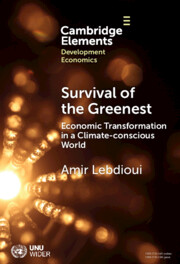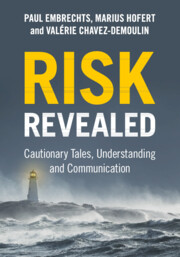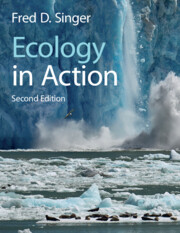1739 results
Chapter 3 - The Carbon Cycle and Climate Change
- from Part I - Introduction and the Physical Environment
-
- Book:
- Ecology in Action
- Published online:
- 04 April 2024
- Print publication:
- 04 July 2024, pp 52-76
-
- Chapter
- Export citation
Introduction
-
- Book:
- Energy and the Environment
- Print publication:
- 02 May 2024, pp 1-11
-
- Chapter
- Export citation

Survival of the Greenest
- Economic Transformation in a Climate-conscious World
-
- Published online:
- 27 April 2024
- Print publication:
- 16 May 2024
-
- Element
-
- You have access
- Open access
- HTML
- Export citation
Can alpine species take the heat? Impacts of increased temperatures on early life stages
-
- Journal:
- Seed Science Research , First View
- Published online by Cambridge University Press:
- 22 April 2024, pp. 1-5
-
- Article
-
- You have access
- Open access
- HTML
- Export citation
JUSTICE IN THE LIMINAL: THE COUNCIL OF EUROPE AND THE RIGHT TO A HEALTHY ENVIRONMENT
-
- Journal:
- International & Comparative Law Quarterly , First View
- Published online by Cambridge University Press:
- 19 April 2024, pp. 1-42
-
- Article
-
- You have access
- Open access
- HTML
- Export citation
Chapter 21 - Impact of Weather and Climate Change on Mass Gathering Events
-
-
- Book:
- Mass Gathering Medicine
- Published online:
- 11 April 2024
- Print publication:
- 18 April 2024, pp 305-319
-
- Chapter
- Export citation
10 - On Climate Change and Related Risk
-
- Book:
- Risk Revealed
- Published online:
- 05 April 2024
- Print publication:
- 11 April 2024, pp 292-315
-
- Chapter
- Export citation

Risk Revealed
- Cautionary Tales, Understanding and Communication
-
- Published online:
- 05 April 2024
- Print publication:
- 11 April 2024
International Trade Law: A Driver of Climate Action or a Roadblock?
-
- Journal:
- International Journal of Legal Information , First View
- Published online by Cambridge University Press:
- 05 April 2024, pp. 1-17
-
- Article
-
- You have access
- HTML
- Export citation

Ecology in Action
-
- Published online:
- 04 April 2024
- Print publication:
- 04 July 2024
-
- Textbook
- Export citation
THE ‘HIGHEST POSSIBLE AMBITION’ ON CLIMATE CHANGE MITIGATION AS A LEGAL STANDARD
-
- Journal:
- International & Comparative Law Quarterly , First View
- Published online by Cambridge University Press:
- 02 April 2024, pp. 1-33
-
- Article
-
- You have access
- Open access
- HTML
- Export citation
Towards an Energetics of Class: Comparing Energy Protests in India and the United States
-
- Journal:
- Comparative Studies in Society and History , First View
- Published online by Cambridge University Press:
- 01 April 2024, pp. 1-29
-
- Article
-
- You have access
- Open access
- HTML
- Export citation
Nutritional deficiency and ecological stress in the Middle to Final western Jōmon
-
- Journal:
- Antiquity , First View
- Published online by Cambridge University Press:
- 01 April 2024, pp. 1-15
-
- Article
-
- You have access
- Open access
- HTML
- Export citation
24 - Climate Change
-
- Book:
- European Union Law
- Published online:
- 19 March 2024
- Print publication:
- 28 March 2024, pp 1001-1047
-
- Chapter
- Export citation
1 - Energy in the Modern World
-
- Book:
- Renewable Energy Engineering
- Published online:
- 08 March 2024
- Print publication:
- 28 March 2024, pp 1-24
-
- Chapter
- Export citation
The Subterranean Unsettling of Science, Race, and Religion: Obeah, Petroleum Geology, and Risk in Trinidad
-
- Journal:
- Comparative Studies in Society and History , First View
- Published online by Cambridge University Press:
- 27 March 2024, pp. 1-27
-
- Article
-
- You have access
- Open access
- HTML
- Export citation
Interactions between seed functional traits and environmental factors and their influence on germination performance of Australian native species
-
- Journal:
- Seed Science Research , First View
- Published online by Cambridge University Press:
- 25 March 2024, pp. 1-16
-
- Article
-
- You have access
- Open access
- HTML
- Export citation
Navigating transformations: Climate change and international law
-
- Journal:
- Leiden Journal of International Law , First View
- Published online by Cambridge University Press:
- 25 March 2024, pp. 1-22
-
- Article
-
- You have access
- Open access
- HTML
- Export citation
For whom and by whom is glaciology?
-
- Journal:
- Journal of Glaciology , First View
- Published online by Cambridge University Press:
- 21 March 2024, pp. 1-11
-
- Article
-
- You have access
- Open access
- HTML
- Export citation
Climate change, energy production, and Arctic tourism: A case study analysis of northern Alaska
-
- Journal:
- Polar Record / Volume 60 / 2024
- Published online by Cambridge University Press:
- 21 March 2024, e10
-
- Article
-
- You have access
- Open access
- HTML
- Export citation



